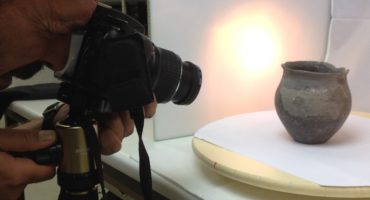Our Cultural institutions Page highlights our ongoing support of museums and cultural institutions with free accounts and access to tools. In Cultural Heritage Spotlight, we’ll explore museums and cultural institutions who are using 3D technology to bring new life to their collections.
The African Conservation Trust (ACT) is a South African non-profit organisation that has been using 3D laser scanning to document South Africa’s unique cultural heritage sites. From ancient San rock art to historic battlefield sites, ACT together with the University of KwaZulu-Natal (UKZN) have been reviving the past with cutting-edge technology.
Rock Art
South Africa is home to one of the world’s most spectacular mountain chains, the uKhahlamba Drakensberg Park (UDP). Originally called Khahlamba by the Bantu-speakers, the name means ‘the row of upward-pointing spears’. In these mountains and in the foothills below lies a treasure trove of priceless art left behind as a legacy of the oldest known inhabitants of South Africa, the San people. The mysterious Drakensberg rock art often depicting supernatural scenes that were seen by the Shaman in a trance state has been regarded as the only tangible record left of the San, who for the past 100 years have been considered an extinct people and culture. Unfortunately much of the rock art has been damaged by vandalism, fire, vegetation and natural weathering. ACT has been working with UKZN to digitally preserve these spectacular sites using 3D laser scanning.
Corbelled Houses
American non-profit, CyArk, initiated the CyArk 500 Challenge, an ambitious project that aims to document 500 significant heritage sites around the world in 5 years. ACT and UKZN took up the challenge and travelled to the Northern Cape province of South Africa to document nine corbelled houses using 3D laser scanning. The corbelled houses are excellent examples of the ingenuity of the early Dutch pioneers who moved into the Karoo semi-desert landscape from about 1820 through to the end of the nineteenth century. They discovered that trees were sparse and set about building their dwellings using the only available material, stone. As there could be no wooden trusses to support the roof, they made use of an ancient method of construction known as corbelling. The corbelled buildings of the Northern Cape are the only examples in Southern Africa that still stand today and represent a special phase in the history of vernacular architecture in South Africa.
Documenting Historic Zulu Kingdoms
The documentation team has just completed the scanning of the Zulu King Dingane’s royal capital (uMgungundlovu) which was established in 1829. Dingane rose to power after murdering his half-brother, King Shaka. Whilst initially reassuring his people that he was a man of peace, he soon became just as paranoid and brutal as Shaka, murdering anyone whose loyalties were in question. He decided to build his grand royal kraal in the Emakhosini Valley. uMgungundlovu was oval in shape, and consisted of about 1500 traditional grass huts (umuzi). Though the original capital was burnt to the ground, archaeologists are raising it from the ashes and reconstructed huts show what it was like in its prime.
uMgungunglovu is well-known for the brutal killing of Voortrekker leader Piet Retief and his men, a significant and controversial chapter in the history of the country. In November 1837 Dingane met with Piet Retief, leader of the Voortrekkers (early Dutch settlers). In return for their recovering some stolen cattle, Dingane signed a deed of cession of lands to the Voortrekkers. After two days of feasting, Retief was asked to report with his men and servants to the parade ground so that the king could wish them farewell. As a mark of respect they were asked to leave their guns outside. The Boers, seated on the ground were surrounded by a large group of dancers that performed a long dance, at one point Dingane stopped, raised his arm to absolute silence and shouted again and again ‘Bulalani abathagathi!’ – Kill the wizards! The men were totally overpowered and dragged away to a hill called kwaMatiwane where Retief and his men were brutally murdered. In a further act of war, Dingane ordered his army also to seek and kill the group of Voortrekkers under Andries Pretorius. The Zulu impis attacked the Voortrekker encampment, but they were crushingly defeated in the ensuing Battle of Blood River. An estimated 3,000 Zulus were killed, while three Voortrekkers were slightly wounded. uMgungundlovu was finally burnt down on the order of Dingane soon after the Battle of Blood River.
Thank you for sharing, African Conservation Trust!
If you are part of a cultural institution, get in touch with us at museums@sketchfab.com to set up your free business account.



